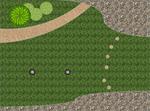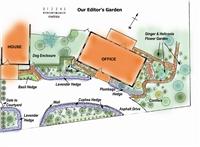Landscape Designer or Landscape Architect
 Lots of different terms are used loosely to describe people who design landscapes. A landscape can be any outside environment from a garden, to a park, a roadside area, a car park, a roof top or a reclaimed mine site. A landscape normally has plants in it but not always. It may be a relatively uncomplicated design that contains uncomplicated structural features such as a picket fence or gravel path. Alternatively a landscape can contain very complex components like a bridgestrong enough to carry vehicles or a large automated watering system with hundreds of outlets, or intricate earth formations.
Lots of different terms are used loosely to describe people who design landscapes. A landscape can be any outside environment from a garden, to a park, a roadside area, a car park, a roof top or a reclaimed mine site. A landscape normally has plants in it but not always. It may be a relatively uncomplicated design that contains uncomplicated structural features such as a picket fence or gravel path. Alternatively a landscape can contain very complex components like a bridgestrong enough to carry vehicles or a large automated watering system with hundreds of outlets, or intricate earth formations.
What They Do
- Landscape architects, like engineers, have the capacity to formulate and deal with very complex designs that may involve complex mathematical calculations, and apply their understanding of construction. However a landscape architect may not necessarily have as much understanding of plants as a garden designer does.
- The garden designer draws plans for a garden to create a layout that is both functional and aesthetic and almost always has planting design at its c
 ore. Landscape designers may specialise e.g. water gardens, playgrounds, natural gardens, permaculture gardens etc.
ore. Landscape designers may specialise e.g. water gardens, playgrounds, natural gardens, permaculture gardens etc.
WhereThey Work
-
Landscape architects usually work on more costly projects; such as public gardens, commercial and industrial properties and large private gardens.
- Garden designers work across a range of domestic and commercial gardens.
What is Needed
Landscape architects usually undertake university level studies; either a bachelor degree or post graduate qualifications in landscape architecture. They may move into this field following studies and/or working in related disciplines such as urban planning, engineering, environ mental science or horticulture.
mental science or horticulture.
Landscape designers start out by either
working on the job, or more commonly doing a certificate or diploma
course. The course they do must focus on gathering broad plant knowledge and their correct culture as well as design; this is not always the case.
Landscape architects and garden designers need the following:
- An ability to survey a site and collect all relevant information, including topography.
- Ability to identify several hundred plant species that can be used in a design.
- An understanding of how plants grow and what is appropriate to plant under what conditions (e.g. soil, light, water, wind, heat, cold, etc.)
- Knowledge of hard landscaping components and how to design (engineer) them and how to use them in a design.
- An ability to draw a garden plan (either on paper or on a computer).
Opportunities
Some government departments, as well as consulting engineers,
planners and even large landscape contracting firms, may employ
landscape architects on permanent staff.
- Landscape architects may find
more work available when governments are spending big, and less when tax
revenue is under pressure.
- Many landscape architects are self-employed,
or work in a small business with one or two partners. Landscape
architects can earn a great deal more than garden designers, but the
amount of work at that level is always going to be far less than for
landscape designers.
- Landscape architects can become more viable if they diversify the
services they offer, perhaps into things such as environmental assessment, media, teaching or consulting.
Landscape design work has increased significantly in recent decades, driven by two things:
- Municipal governments requiring landscape plans to be submitted and approved on building projects.
- Time constraints – i.e. both partners in a household work and lack time for input into resulting in an increase in all home
services including garden design.
Many garden designers are self-employed, and often garden design might
be only a part time occupation coupled with
garden maintenance. Offering garden design becomes easier when you are already have a client base in garden maintenance; this can be further increaed by word of mouth. To build a viable garden design practice requires some effective marketing -
perhaps building an alliance with a plant nursery, landscape contractor
or supplier of landscape materials. Some even work for a firm of
landscape architects to provide the planting designs.
More from ACS
Ebook - Advice from professional horticulturists with decades in the industry.
View eBook
Ebook - Whether you work for yourself or someone else, you need to be able
to present what you have to offer in a way which attracts employers.
As a consultant, you need to stand out from others in your field.
View eBook
Ebook - A classic that has helped many to start up and run a successful business.
View eBook
Course - Popular design certificate that has launched many enthusiastic and talented design students into the industry.
View Course
Become a Landscape Professional in 2 to 3 years
View Course